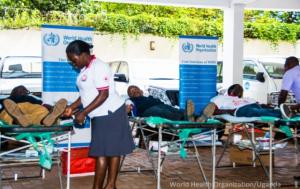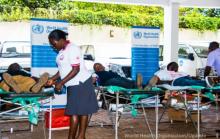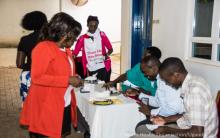UN staff in blood donation drive
Kampala, 8 July 2016 -- 14th June every year is World Blood Donor Day. It is meant to raise awareness on the need for safe blood and blood products and to thank voluntary blood donors who save millions of human lives globally through blood donations.
The theme for this year’s World Blood Donor Day was “Blood connects us all”. It was meant to highlight the common bond that all people share in their blood.
The World Health Organization (WHO) country office in Uganda together with the Uganda Blood Transfusion Services organized a blood donation drive at the office premises in commemoration of the day. The blood donation drive targeted United Nations staff in Uganda, their families and the general public.
Launching the donation drive, Dr. Solomon Woldetsadik from WHO recognized the increase in the number of people who give blood voluntarily and regularly saying that “this is the only means of ensuring that safe blood is accessible to every patient who needs it.” He further highlighted the importance of safe blood saying “Safe blood donors are the cornerstone of a safe and adequate supply of blood.”
Nearly 50% of inpatient deaths among children under-five are attributed to malaria which causes severe anaemia. Therefore, 50% of all blood collected in Uganda is used to treat these children.
Haemorrhage contributes 34% to all maternal deaths in Uganda. 30% of donated blood is used to save lives of pregnant women with complications of pregnancy and child birth, including haemorrhage and malaria-induced anaemia.
Despite impressive strides in blood donation, in the fiscal year 2011/2012, blood supply in Uganda , at just over 200,000 units, fell 10% short of official hospital demand, and 30% short of the World Health Organization (WHO) target for blood collection. According to WHO standards, a country is supposed to collect units of blood equivalent to 1% of the total population if all transfusion needs are to be met that is approximately 350,000 units.
NOTE
In the WHO African Region, the demand for transfusion of blood and blood products is high and the national blood transfusion services are facing the challenge of making sufficient, safe and quality blood and blood products available. From 2013 to 2016, blood donations rose from about 3.9 million units to 4.4 million units. That is 11.4 percent of increase, but this will still cover only around 50 percent of the annual requirement of blood. So far, only 21 countries are collecting 80 to 100 percent of their national blood needs through voluntary unpaid blood donors.
______________________________
01 Blood donation in full gear
02 WHO staff and the general public register to donate blood





